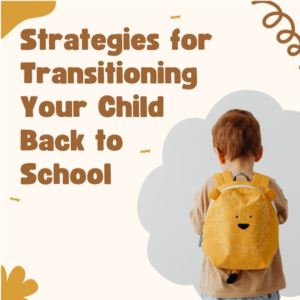As we enter the month of August, we feel summer start to gradually wind down. The back-to-school season brings a mix of excitement and anxiety for many families. For parents and caregivers of autistic children, the transition back to structured routines and social environments can pose unique challenges. With careful planning and understanding, this time can be made smoother and less stressful for everyone involved.
Understanding the Challenges
Autistic children thrive on predictability and routine. The shift from the relaxed summer schedule back to the demands of school can be disruptive and overwhelming. Sensory sensitivities, social anxieties, and changes in routine can all contribute to difficulties during this transition.
Strategies for a Successful Transition
- Gradual Adjustment: Start re-establishing school-year routines well before the first day. Gradually adjust bedtimes and wake-up times to align with the school schedule. Reintroduce homework or quiet reading periods into the daily routine.
- Visual Schedules: Visual aids are invaluable tools for autistic children. Create a visual schedule that outlines the morning routine, school day, and after-school activities. This can help reduce anxiety by providing a clear overview of what to expect.
- Social Stories: Social stories are short narratives that describe a specific situation or event, helping children understand social cues and expectations. Create social stories about going back to school, meeting new teachers, or riding the bus to prepare them for these experiences.
- Sensory Considerations: Be mindful of sensory sensitivities. If your child is sensitive to certain noises or textures, prepare them with noise-canceling headphones or sensory-friendly clothing. If possible, talk to the school about creating a designated quiet space where your child can decompress if needed.
- Visit the School: If your child is new to the school or hasn’t been there in a while, arrange a visit before classes start. Familiarizing themselves with the environment, their classroom, and maybe even their teacher can significantly ease anxiety.
- Open Communication: Maintain open communication with your child’s teachers and school staff. Share information about your child’s strengths, challenges, and any accommodations that may be needed. Work together to create a supportive and understanding environment.
- Celebrate Successes: Acknowledge and celebrate even small victories during the transition. Positive reinforcement can go a long way in building confidence and reducing stress.
Remember: Every child is unique, and what works for one may not work for another. Be patient, flexible, and adaptable. Listen to your child’s needs and tailor your approach accordingly. With the right support, the back-to-school transition can be a positive experience for both you and your child.


